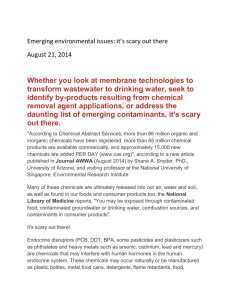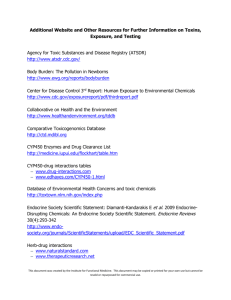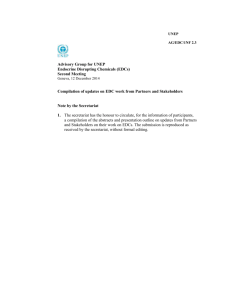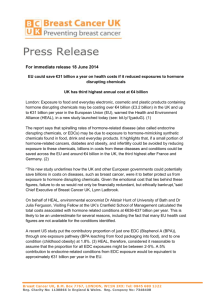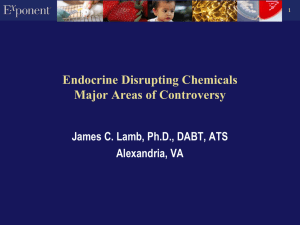Endocrine Disrupting Chemicals—Draft Position Statement
advertisement
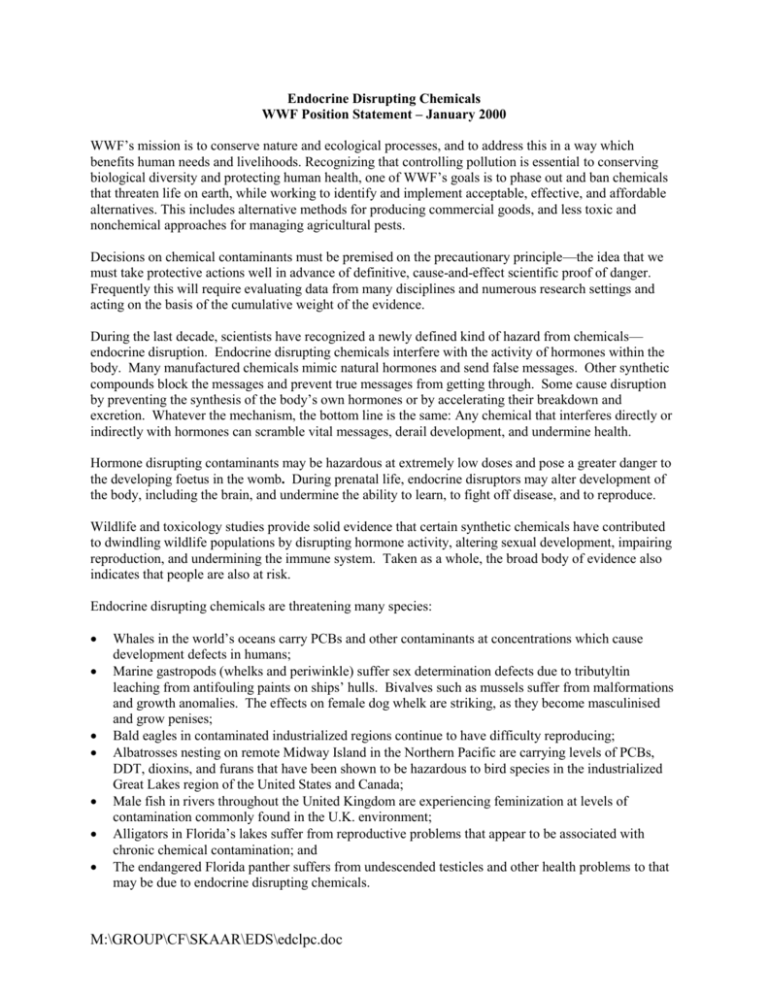
Endocrine Disrupting Chemicals WWF Position Statement – January 2000 WWF’s mission is to conserve nature and ecological processes, and to address this in a way which benefits human needs and livelihoods. Recognizing that controlling pollution is essential to conserving biological diversity and protecting human health, one of WWF’s goals is to phase out and ban chemicals that threaten life on earth, while working to identify and implement acceptable, effective, and affordable alternatives. This includes alternative methods for producing commercial goods, and less toxic and nonchemical approaches for managing agricultural pests. Decisions on chemical contaminants must be premised on the precautionary principle—the idea that we must take protective actions well in advance of definitive, cause-and-effect scientific proof of danger. Frequently this will require evaluating data from many disciplines and numerous research settings and acting on the basis of the cumulative weight of the evidence. During the last decade, scientists have recognized a newly defined kind of hazard from chemicals— endocrine disruption. Endocrine disrupting chemicals interfere with the activity of hormones within the body. Many manufactured chemicals mimic natural hormones and send false messages. Other synthetic compounds block the messages and prevent true messages from getting through. Some cause disruption by preventing the synthesis of the body’s own hormones or by accelerating their breakdown and excretion. Whatever the mechanism, the bottom line is the same: Any chemical that interferes directly or indirectly with hormones can scramble vital messages, derail development, and undermine health. Hormone disrupting contaminants may be hazardous at extremely low doses and pose a greater danger to the developing foetus in the womb. During prenatal life, endocrine disruptors may alter development of the body, including the brain, and undermine the ability to learn, to fight off disease, and to reproduce. Wildlife and toxicology studies provide solid evidence that certain synthetic chemicals have contributed to dwindling wildlife populations by disrupting hormone activity, altering sexual development, impairing reproduction, and undermining the immune system. Taken as a whole, the broad body of evidence also indicates that people are also at risk. Endocrine disrupting chemicals are threatening many species: Whales in the world’s oceans carry PCBs and other contaminants at concentrations which cause development defects in humans; Marine gastropods (whelks and periwinkle) suffer sex determination defects due to tributyltin leaching from antifouling paints on ships’ hulls. Bivalves such as mussels suffer from malformations and growth anomalies. The effects on female dog whelk are striking, as they become masculinised and grow penises; Bald eagles in contaminated industrialized regions continue to have difficulty reproducing; Albatrosses nesting on remote Midway Island in the Northern Pacific are carrying levels of PCBs, DDT, dioxins, and furans that have been shown to be hazardous to bird species in the industrialized Great Lakes region of the United States and Canada; Male fish in rivers throughout the United Kingdom are experiencing feminization at levels of contamination commonly found in the U.K. environment; Alligators in Florida’s lakes suffer from reproductive problems that appear to be associated with chronic chemical contamination; and The endangered Florida panther suffers from undescended testicles and other health problems to that may be due to endocrine disrupting chemicals. M:\GROUP\CF\SKAAR\EDS\edclpc.doc Although the investigation of human health effects has just begun, researchers have already found immune system changes, neurological and motor delays, and learning problems in children associated with exposure in the womb to background levels of PCBs. Indeed, World Health Organization experts have recognized that “subtle effects may already occur in the general population in developed countries at current background levels of dioxins and dioxin-like PCBs.” Epidemiological studies are documenting disturbing trends showing that people are increasingly suffering from health problems similar to those observed in wildlife and laboratory studies of animals exposed to synthetic EDCs. Coming to grips with threats from endocrine disrupting chemicals will require a shift to different ways of making judgments about environmental contaminants and a new standard for taking action. There is little chance of showing a cause-and-effect link between EDCs and clinical diseases and/or functional impairments in humans. To protect public health in the real world—where people and wildlife are exposed to complex mixtures of chemicals and where the consequences may not surface until decades later—we need to assess research results based on “the weight of the evidence.” This approach relies on accumulating evidence and common sense inferences rather than on scientific ideals of proof that are more appropriate for controlled laboratory experiments. For example, the conclusion that smoking cigarettes causes lung cancer was drawn based on the weight of evidence long before the link and mechanism were conclusively demonstrated. The stakes in the endocrine disruption problem are high. If the hazards are as great as some research indicates, delaying control and elimination of EDCs means condemning future generations of wildlife and people to irreversible harm. Even though scientific uncertainties remain about the hazards posed by EDCs, there is more than enough known to act now. WWF seeks: national, multi-national, and international action to control and, where necessary, ban, the use of EDCs which are already known to have harmful effects; increased use of the “precautionary principle” in public decision making, recognizing that actions should be taken to prevent harm from chemicals even when definitive scientific information on causeeffect relationships is incomplete; development and implementation of screens and tests to evaluate chemicals for endocrine disrupting activity; increased public and private sector investment in research on endocrine disrupting chemicals; legislative mechanisms which lead to the substitution of potentially hazardous substances with less hazardous or preferably non-hazardous substances or processes, without waiting for definitive proof of harmful effects; and proactive efforts by manufacturers and users of endocrine disrupting substances to phase out their use. WWF will: promote amendment of national and international laws and policies to officially recognize the threat of endocrine disruption from individual chemicals and mixtures of chemicals; strategically engage producers and users of EDCs to achieve phase-outs, by urging precautionary action that relies on less-toxic alternative approaches; encourage the development of new screens and tests for endocrine disruption; advocate incorporation of the “precautionary principle” in public decision making on chemicals; work towards increased research on EDCs and promote creation of an innovative public-private partnership to oversee scientific research that is untainted by its funding sources; and M:\GROUP\CF\SKAAR\EDS\edclpc.doc synthesize emerging scientific findings from pertinent disciplines to raise public awareness of new developments and identify areas for additional research investments. WWF’s initiatives on endocrine disrupting chemicals have taken many forms. WWF was successful at the International Maritime Organization in promoting a phaseout of tributyltin. WWF-Canada has pushed for phase-outs of alkylphenol ethoxylates. WWF-Canada and WWF-US have worked with fruit and vegetable growers to reduce use of pesticides. WWF-Germany has worked to phase out triazine herbicides in Germany. In Europe, WWF has played a leading role in securing a European Parliament resolution on endocrine disrupting chemicals, and is actively lobbying for improvements to European chemicals legislation. WWF in Europe also has played a lead role in promoting work on endocrine disruptors within the OSPARCOM framework for protection of the North Sea. WWF-US has made major contributions to design and implementation of the U.S. Environmental Protection Agency’s program for screening and testing endocrine disrupting chemicals, in addition to producing numerous scientific reports on endocrine disrupting chemicals. WWF-UK has published numerous analyses of chemical hazards, including “Chemical Trespass: A Toxic Legacy,” which highlights chemical contamination of human breast milk. More detailed information on endocrine disrupting chemicals is available on the websites of WWF-US (www.worldwildlife.org/toxics), WWF-Canada (www.wwfcanada.org,), WWF-UK (www.wwf-uk.org), WWF-Germany (www.wwf.de), and WWF Northeast Atlantic Program (www.ngo.grida.no/wwfneap). See. e.g., the issue brief, “Chemicals that Compromise Life: A Call to Action,” (Sept. 1998) that is available on the WWFUS website. M:\GROUP\CF\SKAAR\EDS\edclpc.doc

